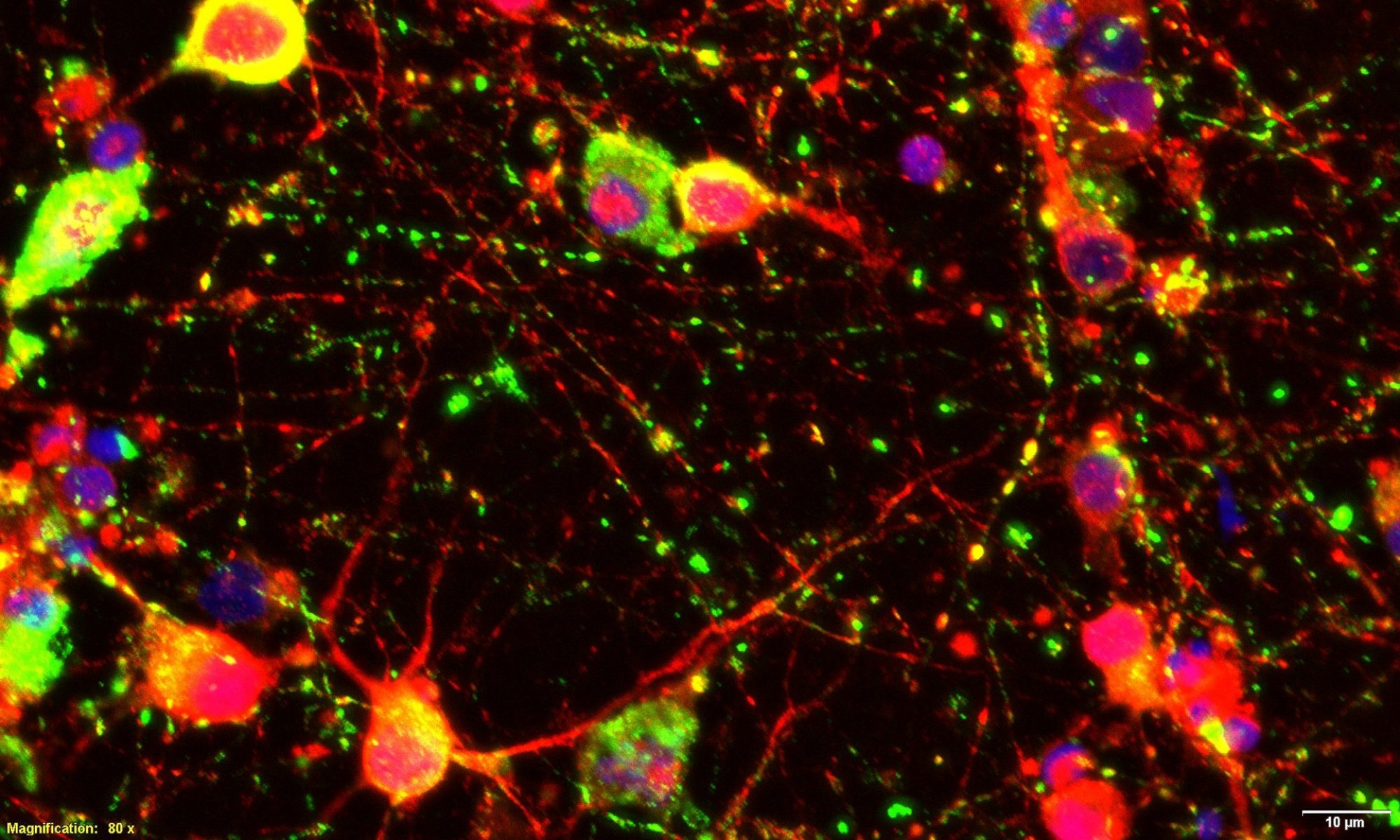Recent Publications:
- Morozko E. L., Smith-Geater C., Monteys A. M., Pradhan S., Lim R. G., Langfelder P., Kachemov M., Hill A., Stocksdale J. T., Cullis P. R., Wu J., Ochaba J., Miramontes R., Chakraborty A., Hazra T. K., Lau A., St-cyr S., Orellana I., Kopań L., Wang K. Q., Yeung S., Leavitt B. R., Reidling J. C., Yang W. X., Steffan J. S., Davidson B. L., Sarkar P. S., Thompson L. M., PIAS1 modulates striatal transcription, DNA damage repair, and SUMOylation with relevance to Huntington’s disease. Proc. Natl. Acad. Sci. U. S. A. 118, 1–11 (2021) DOI:10.1073/pnas.2021836118.
- Smith-Geater, C.*, Hernandez, S.J.*, Lim, R.G., Adam, M., Wu, J. Stocksdale, J.T. Wassie, B.T., Gold, M.P., Wang, K.Q., Miramontes, R., Kopan, L., Orellana, I., Joy, S., Kemp, P.J., Allen, N.D., Fraenkel, E#., Thompson, L.M#. (2020). Aberrant development corrected in adult-onset Huntington’s disease iPSC-derived neurons via WNT signaling modulation. Stem Cell Reports 10;14(3):406-419. doi: 10.1016/j.stemcr.2020.01.015. Epub 2020 Feb 27.
- Crapser, J., Ochaba, J., Soni, N., Reidling, J.C., Thompson, L.M.*, Green, K.* (2020). Microglia facilitate brain volume loss and extracellular matrix changes in the R6/2 mouse model of Huntington’s disease. * co-senior authors. Jan 1;143(1):266-288.
- Gao, R. Chakraborty, A., Geater, C., Pradhan, S. Gordon, K.L., Snowden, J., Yuan, S., Dickey, A.S., Choudhary, S.,Ashizawa, T., Ellerby, L.M. La Spada, A.R., Thompson, L.M., Hazra, T.K, and Sarkar, P.S. (2019). Mutant huntingtin impairs PNKP and ATXN3, disrupting DNA repair and transcription. eLife Apr 17;8. pii: e42988. doi: 10.7554/eLife.42988.PMID: 30994454
- Ochaba, J., Fote, G., Kachemov, M. Thein, S. Yeung, S.Y., Lau, L., Hernandez, S. Lim, R.G., Casale, M., Neel, M.J., Monuki, E.J., Reidling, J.,Housman, D.E., Thompson, L.M. and Steffan, J.S. (2019). IKKß slows Huntington’s Disease progression in R6/1 Mice. Proc. Natl. Acad. Sci May 28;116(22):10952-10961. doi: 10.1073/pnas.1814246116.
- Reidling JC, Relaño-Ginés A, Holley SM, Ochaba J, Moore C, Fury B, Lau A, Tran AH, Yeung S, Salamati D, Zhu C, Hatami A, Cepeda C, Barry JA, Kamdjou T, King A, Coleal-Bergum D, Franich NR, LaFerla FM, Steffan JS, Blurton-Jones M, Meshul CK, Bauer G, Levine MS, Chesselet MF, Thompson LM. (2018). Human Neural Stem Cell Transplantation Rescues Functional Deficits in R6/2 and Q140 Huntington’s Disease Mice. Stem Cell Reports. Jan 9;10(1):58-72. doi: 10.1016/j.stemcr.2017.11.005. Epub 2017 Dec 7.PMID:29233555
- HD iPSC Consortium (2017)*. Developmental alterations in Huntington’s disease neural cells and pharmacological rescue in cells and mice. Nat Neurosci. May;20(5):648-660. doi: 10.1038/nn.4532. Thompson*, corresponding author.
- Lim, R.G., Quan, C., Reyes-Ortiz, A.M., Lutz, S.E., Kedaigle, A.J., Gipson, T.A., Wu, J.,Vatine, G.D., Stocksdale, J., Casale, M.S., Svendsen, C.N., Fraenkel, E., Housman, D.E., Agalliu, D.* and Thompson, L.M. (2017). Huntington’s disease iPSC-derived brain microvascular endothelial cells reveal WNT-mediated angiogenic and blood-brain barrier deficits. Cell Reports 16;19(7):1365-1377. doi: 10.1016/j.celrep.2017.04.021.
- Ochaba, J., Mas Monteys, Al., O’Rourke, J.G., Reidling, J., Steffan, J.S., Davidson, B.L., and Thompson, L.M. (2016). PIAS1 regulates mutant Huntingtin accumulation and Huntington’s disease-associated phenotypes in vivo. Neuron 90:507-520.
Selected Publications: - Huntington’s Disease Collaborative Research Group (1993). A Novel Gene Containing a Trinucleotide Repeat That is Expanded and Unstable on Huntington’s Disease Chromosomes. Cell 72, 971-983. Author list*
- Shiang*, L.M. Thompson*, Y.Z. Zhu, T. Fielder, D. Church, S. Winoker and J.J. Wasmuth (1994). Mutations in the Transmembrane Domain of FGFR3 Cause the Most Common Genetic Form of Dwarfism, Achondroplasia. Cell 78, 335-342. *contributed equally.
- S. Steffan, L. Bodai, J.Pallos, M. Poelman, B. L. Apostol, A. Kazantsev, E. Schmidt, Y.-Z. Zhu, M. Greenwald, R. Kurokawa, D.E. Housman, G.R. Jackson, J. L. Marsh. and L.M. Thompson (2001). Histone deacetylase inhibitors arrest polyglutamine-dependent neurodegeneration in Drosophila. Nature 413, 739-743.
- Vashishtha, M*, Ng, CW*, Yildirim, F*, Gipson, T, Kratter, IH, Bodai, L, Song, W, Lau, A, Labadorf, A, Vogel-Ciernia, A, Troncoso, J, Ross, CA, Bates, GP, Krainc, D, Sadri-Vakili, G, Finkbeiner, S, Marsh, JL, Housman, DE, Fraenkel, E#, Thompson, LM# (2013). Targeting H3K4 trimethylation in Huntington disease. Natl. Acad. Sci. USA 110, E3027-E3036. #Co-Corresponding authors. * co-first authors.
- Keenan AB, Jenkins SL, Jagodnik KM, Koplev S, He E, Torre D, Wang Z, Dohlman AB, Silverstein MC, Lachmann A, Kuleshov MV, Ma’ayan A, Stathias V, Terryn R, Cooper D, Forlin M, Koleti A, Vidovic D, Chung C, Schürer SC, Vasiliauskas J, Pilarczyk M, Shamsaei B, Fazel M, Ren Y, Niu W, Clark NA, White S, Mahi N, Zhang L, Kouril M, Reichard JF, Sivaganesan S, Medvedovic M, Meller J, Koch RJ, Birtwistle MR, Iyengar R, Sobie EA, Azeloglu EU, Kaye J, Osterloh J, Haston K, Kalra J, Finkbeiner S, Li J, Milani P, Adam M, Escalante-Chong R, Sachs K, Lenail A, Ramamoorthy D, Fraenkel E, Daigle G, Hussain U, Coye A, Rothstein J, Sareen D, Ornelas L, Banuelos M, Mandefro B, Ho R, Svendsen CN, Lim RG, Stocksdale J, Casale MS, Thompson TG, Wu J, Thompson LM, Dardov V, Venkatraman V, Matlock A, Van Eyk JE, Jaffe JD, Papanastasiou M, Subramanian A, Golub TR, Erickson SD, Fallahi-Sichani M, Hafner M, Gray NS, Lin JR, Mills CE, Muhlich JL, Niepel M, Shamu CE, Williams EH, Wrobel D, Sorger PK, Heiser LM, Gray JW, Korkola JE, Mills GB, LaBarge M, Feiler HS, Dane MA, Bucher E, Nederlof M, Sudar D, Gross S, Kilburn DF, Smith R, Devlin K, Margolis R, Derr L, Lee A, Pillai A. (2018). The Library of Integrated Network-Based Cellular Signatures NIH Program: System-Level Cataloging of Human Cells Response to Perturbations. Cell Syst. Jan 24;6(1):13-24. doi: 10.1016/j.cels.2017.11.001. Epub 2017 Nov 29. Review.PMID:29199020.
